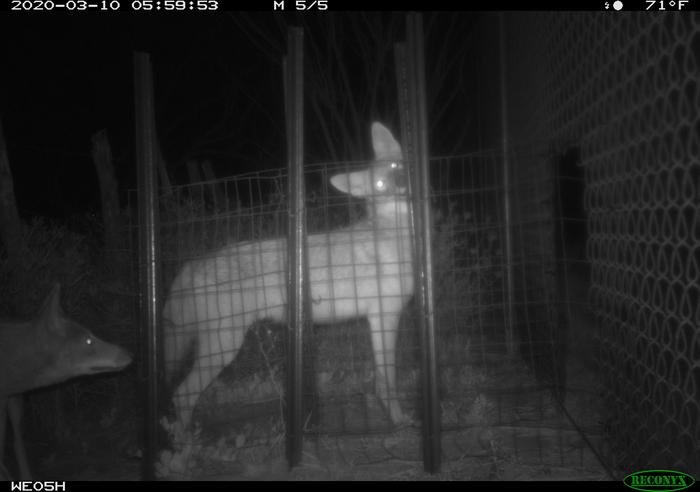The endangered Texas ocelot is in serious trouble due to a combination of over-hunting, habitat loss, inbreeding, and getting hit by cars. Only two populations of these bobcat sized spotted and striped carnivores remain in Texas and they’re isolated from a larger population living in northwestern Mexico by highways and buildings.
[Related: Watch bobcats, bears, and even birds use fallen logs as bridges.]
One conservation measure to help endangered ocelots and other animals near busy roads are special wildlife exits. A study published October 13 in the journal Frontiers in Ecology and Evolution found that 10 mammal species use these special structures, which could help prevent more collisions with traffic.
Chain-link fencing along Texas highways has been used to reduce wildlife mortality from colliding with cars and trucks. However, this fencing can trap animals that get on the highway if they jump over or burrow under the fencing. In 2018, the Texas Department of Transportation built 10 exits for the endangered ocelots in an effort to keep the animals from getting trapped. The openings in the fencing are about 18 inches across and 23 inches wide and are funnel shaped to encourage the ocelots to move away from the highway and into the surrounding habitat.
This new study tested if these wildlife exits are used by medium-sized carnivores in Texas. Two automatic cameras were installed at each of the 10 wildlife exits along a 7.3-mile stretch of State Highway 100 between Los Fresnos and Laguna Vista. The cameras were inspected every month between February 2019 and November 2020 and a team of scientists downloaded the images and sorted them into species.
They found that the wildlife exits were used by 10 mammal species to get off the highway. The species ranged from the smaller black-tailed jackrabbits and Virginia opossums up to bobcats and coyotes. For the coyotes and bobcats, their activity peaked around 10 PM and then again between midnight and dawn.
 Two coyotes using a wildlife exit to leave the road. CREDIT: Kline Lab/University of Texas Rio Grande Valley.
Two coyotes using a wildlife exit to leave the road. CREDIT: Kline Lab/University of Texas Rio Grande Valley.
“Here we show that a range of species, including middle-sized carnivores such as bobcats and coyotes, successfully use wildlife exits, a new type of mitigation structure specifically designed for the US endangered ocelot,” study co-author and former University of Texas Rio Grande Valley graduate student said in a statement.
While the ocelots themselves were not photographed using the exits due to their small numbers, other automatic cameras near the highway saw them. About 43 percent of bobcats, a surrogate species for the ocelot, used the exits. According to the team, observing bobcats and coyotes using the exits implies that the endangered ocelots are likely to do so as well.
[Related: Grizzlies are getting killed by roads, but the risks are bigger than roadkill.]
“We anticipated that the extreme rarity of ocelots would limit the amount of data collected on that species,” study co-author and conservation biologist at the University of Texas Rio Grande Valley Kevin Ryer said in a statement. “For this reason, we also focused on more common bobcats and coyotes, as they have similar habitats, diets, body sizes, and behaviors as ocelots, with overlapping home ranges between them.”
The largest local species including white-tailed deer, nilgai, and javelina, could not use the narrow wildlife exits. Tunnels and crossing girds are the best methods for helping these bigger animals avoid traffic collisions.
While the exits appear to function as designed, additional research could create improvements that prevent wildlife from going in the wrong direction. These wildlife exits also have the potential to be a valuable conservation measure on Texas highways.
“Wildlife collision mitigation is less expensive to implement during the construction phase of highways than retrofitting mitigation after construction,” study co-author and University of Texas Rio Grande Valley biologist Richard Kline said in a statement. “Although the entire wildlife community near the highway should be considered when planning mitigation, endangered species should be the focus.”

>>> Read full article>>>
Copyright for syndicated content belongs to the linked Source : Popular Science – https://www.popsci.com/environment/wildlife-exit-ocelots/















![[News] Japan Develops 10nm Nanoimprint Technology, with Potential to Tackle EUV Bottleneck – TrendForce](https://earth-news.info/wp-content/uploads/2025/12/329851-news-japan-develops-10nm-nanoimprint-technology-with-potential-to-tackle-euv-bottleneck-trendforce-360x180.jpg)















